Everton are one of English football’s most iconic and successful football clubs. The Toffees are top-flight veterans, having been competing among England’s elite — whether that’s known as the Premier League as it is today or the old First Division — since earning promotion via a second-place finish in the Second Division under Cliff Britton in 1953/54. That makes this season the 70th anniversary of the last time they needed to earn promotion.
This also means that 70 years of history almost all came crashing down last season, as Everton were under a major threat of relegation, ultimately surviving by the skin of their teeth as they finished in 17th place, just two points above Leicester City, who won’t be part of England’s pre-eminent competition this term.
The Merseyside club will enter the new season under the guidance of Sean Dyche — an expert at keeping teams up despite significant odds stacked against them. Dyche took over at Goodison Park in late January after Chelsea legend Frank Lampard was sacked after a 2-0 loss to another former club of Lampard the player, West Ham United, left his team floundering in 19th place and winless since October.
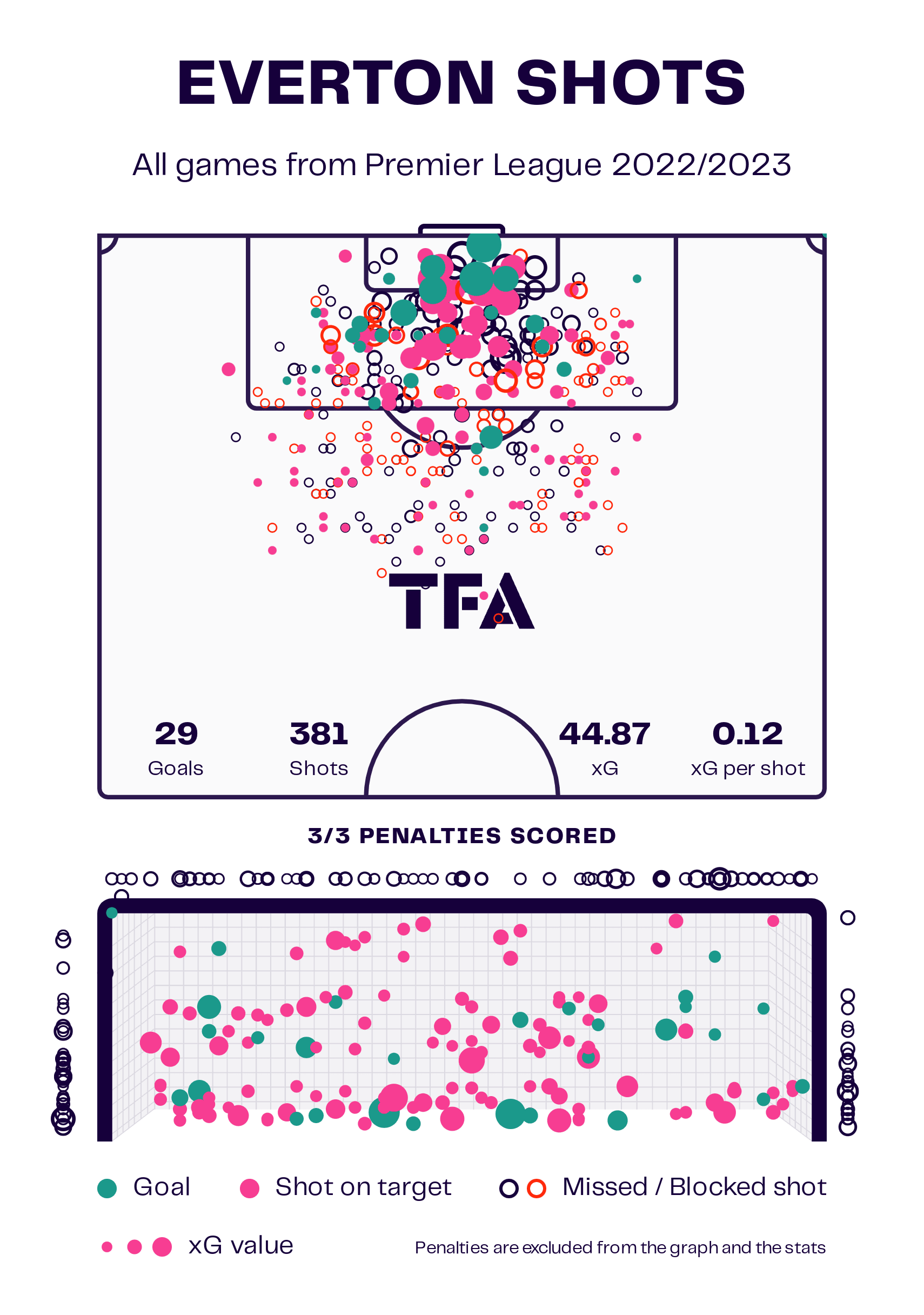
The Toffees ended the 2022/23 campaign, having scored just 29 non-penalty goals from a non-penalty xG of 44.87. This is a significant underperformance based on the quality of chances they were creating and something that they could use to fuel confidence that they can, in fact, improve in the goalscoring department next season, as they’ve already been creating enough chances to be performing at a better level here than they have been performing in reality.
Their record under Dyche can also inspire some confidence here. After Dyche’s arrival, Everton generated 1.47 xG per 90 and scored an average of 1.06 goals per 90. This was a notable improvement over Lampard, whose side generated just 1.04 xG per 90 and scored 0.75 goals per 90.
The Goodison Park faithful also observed their team taking about three more shots per game under Dyche than they had under Lampard, further indicating the new coach’s positive impact on his team’s attacking performance.
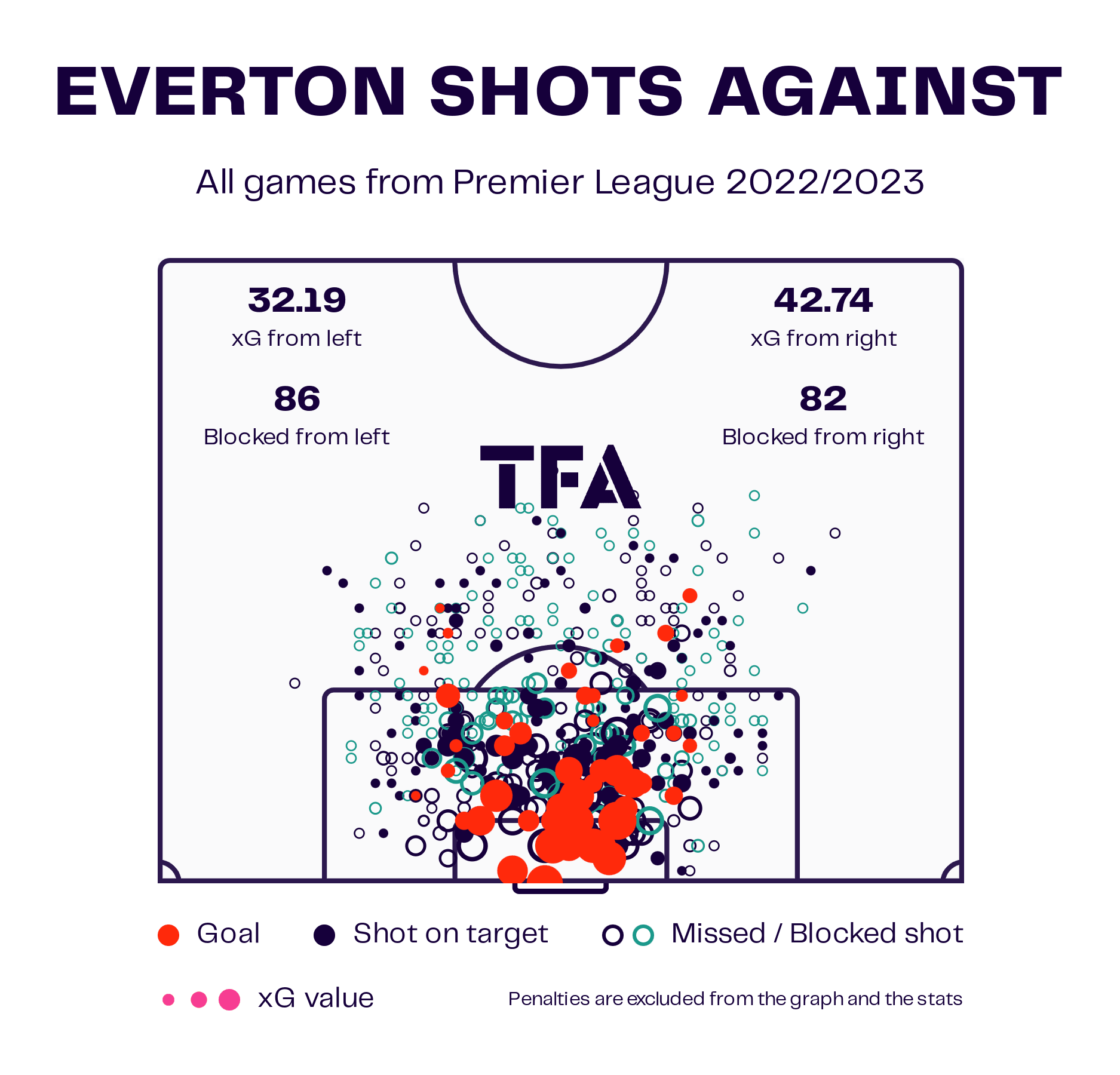
As shown on the shots against visualisation here, Everton conceded 74.93 non-penalty xG, with their right side being more vulnerable than their left. They ended up conceding 52 non-penalty goals last season, so they were actually fortunate not to have conceded more in this instance based on the quality of chances they were shipping.
One potential concern for the Toffees heading into the new season is that they conceded 0.21 more goals per 90 under Dyche than they’d conceded prior to the former Burnley boss’ arrival at Goodison Park. So, while Dyche influenced a positive change going forward, there remains work to do on keeping goals out at the other end of the pitch.

At the time of writing, Moise Kean, Ellis Simms, Niels Nkounkou Asmir Begović, Yerry Mina, Andros Townsend and Tom Davies are all of the players Everton have seen leave the club this summer.
Meanwhile, they’ve only managed to bring in Ashley Young at this point, with LaLiga side Villarreal’s Arnaut Danjuma also reportedly close to coming through the door.
The days of owner Farhad Moshiri splashing the cash seem to be well and truly gone, with Ashley Young — the first signing of Sean Dyche’s tenure as manager — representing a far more frugal purchase than, for instance, Marco Silva’s maiden purchase of €39.2m Richarlison back in 2018.
Still, it’s a signing that makes a lot of sense. Dyche is somewhat familiar with the 38-year-old, having played with him as Young initially broke through at Watford. At the same time, Young is exceptionally versatile and comfortable playing on either wing or in either full-back position — with the latter being the more likely destination for his talents this season. Still, Young gives Dyche cover in plenty of areas, options and valuable experience to keep his team playing at the level they’re capable of.
Everton are light in the full-back positions and on the wings. With Young providing cover at both full-back positions, the wing should now be the priority area to get bodies through the door.
Danjuma can play on either wing, with more experience on the left, though he has been playing as a centre-forward more often in recent seasons. The Toffees are reportedly still looking for reinforcements in wide attacking positions, with Leeds United’s Wilfried Gnonto and Manchester United’s Anthony Elanga (the latter of whom seems destined for Nottingham Forest at the time of writing) having been linked with moves to Merseyside.
Of course, Everton will keep their options open as they seek reinforcements on a limited budget, and their recruitment process may continue late into the transfer window. Using our xGOLD Team player similarity tool, Kevin Millodres of Málaga, who was out on loan at Portuguese Primeira Liga side Gil Vicente last season, is an 84% match for Everton in the left-wing position they seem keen to strengthen, so he could be one other option for the club to look at. However, the dangerous dribbler has no experience of playing in Europe’s top-five leagues and likely wouldn’t be an adequate fit quality-wise as much as style-wise.
The Toffees will need to be creative in their recruitment, but certainly, another winger in the door after Danjuma’s arrival seems the next logical signing.
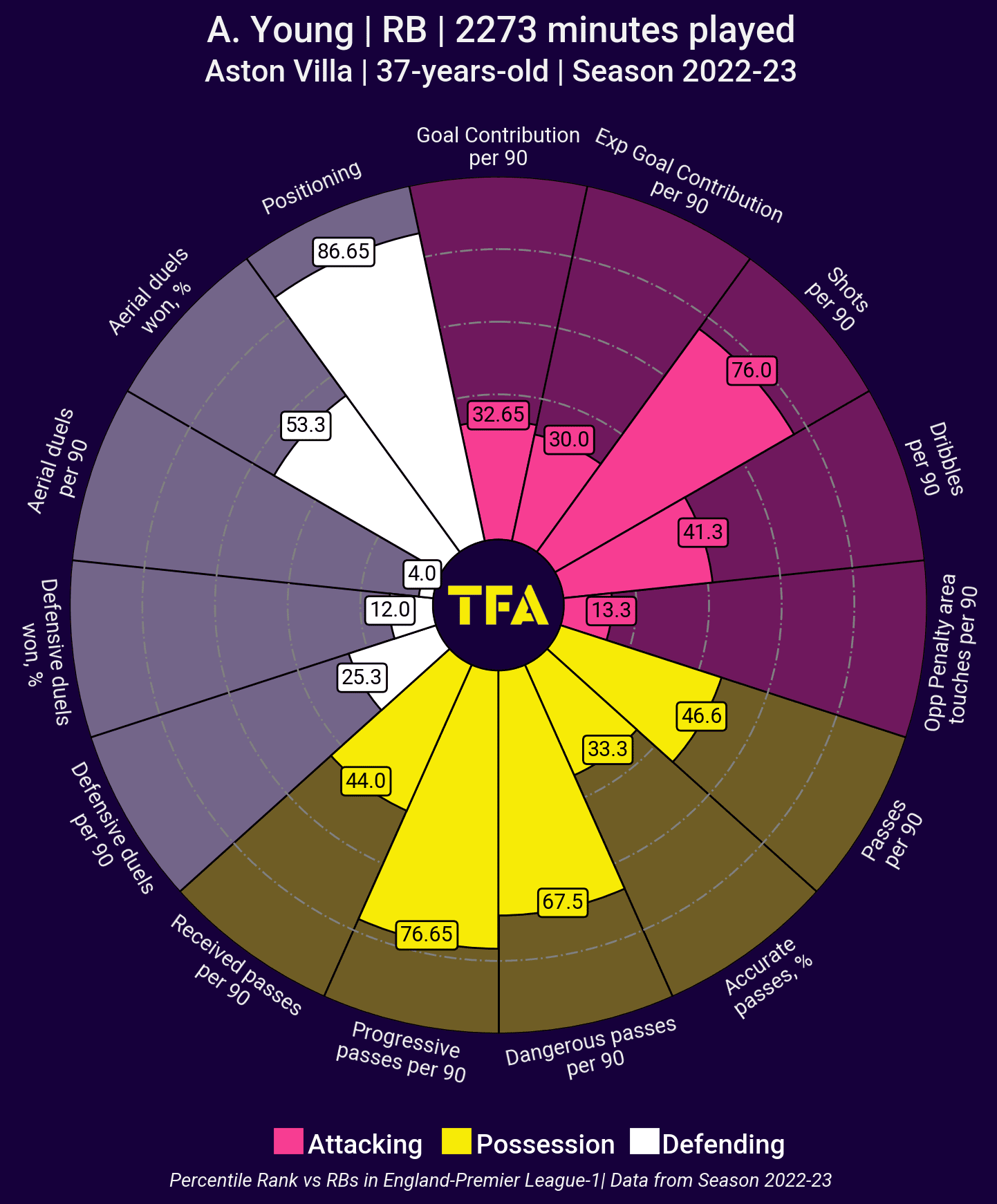
Like last season, Ashley Young will be one of the Premier League’s oldest players next season. Still, he played 2273 minutes for an Aston Villa side that shot up the league following Unai Emery’s October arrival, finishing in seventh place.
Young’s defensive output will be essential for Everton as they look to improve their defence. If Young features on the right, his positioning (with the metric above created by combining tackles and interceptions) will be an important weapon for the Toffees to decrease the number of chances they conceded from the right last season, as observed in the ‘shots against’ visualisation earlier.
Young isn’t the creator he once was; don’t expect to see him flying up and down the wing, landing crosses on Dominic Calvert-Lewin’s head. However, he’s a valuable ball progressor from the deep, wide positions that Everton will look to use to pump balls up the wing and into the channels for their wide and central attackers to chase down. This is an important aspect of Dyche’s in-possession approach, which will be analysed more as we progress in this scout report and tactical analysis.
Attacking phase
In possession, Dyche hasn’t sprung a lot of surprises at Goodison Park so far. His teams don’t have a reputation for playing the prettiest football around, and that’s not what he’s aiming to do, so that’s fine — Everton fans won’t mind that much considering his arrival instigated a vast improvement in front of goal compared with his predecessor.
As mentioned earlier, Dyche’s side scored 0.31 more goals per 90 and generated 0.43 more xG per 90 than Lampard’s Everton managed last term. He did this while changing the style of play considerably, with Dyche’s Everton making almost one less pass per possession than Lampard’s (3.04 compared to 3.90), keeping far less of the ball (39.4% possession compared to Lampard’s 47.5%) along with, naturally, playing far fewer passes (313.06 per 90 compared to Lampard’s 390.4) and having lower pass accuracy (77.6% to Lampard’s 84.0%).
Dyche’s teams play in a direct fashion, with long balls often being pumped up to the forwards from goal-kicks. We’ve observed that Dyche’s Everton tend to play long balls from the ‘keeper more towards the beginning and ending of games, with the middle portion of the game — in which the tempo settles down a bit — seeing them play it shorter from the back a bit more often, though still with the aim of quickly progressing forward.
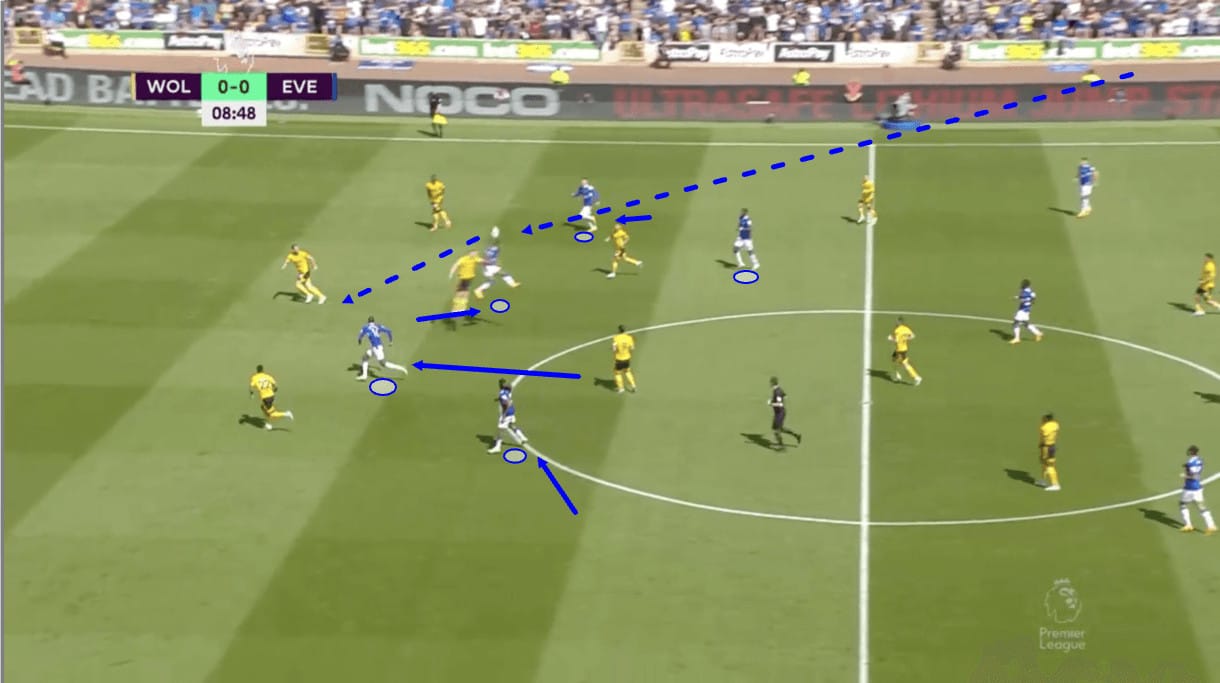
With their long balls, Everton’s ‘keeper will typically aim for the centre-forward, who will likely have four bodies all around him — the wingers and two central midfielders. The wingers come narrow for the long goal-kicks while the central midfielders push up to provide options for the striker to head it down and, crucially, to provide support and pressure on the second ball.
Here in this example, the left central midfielder makes his run beyond the centre-forward — charging in behind the opposition’s backline and giving the striker a great option for a flick-on header, which he takes.
Competing for second balls and applying constant pressure in the middle third of the pitch are vital components of Sean Dyche’s approach. He needs his team to win 50/50 battles and try to keep the opposition moving backwards, applying constant pressure to their defence.
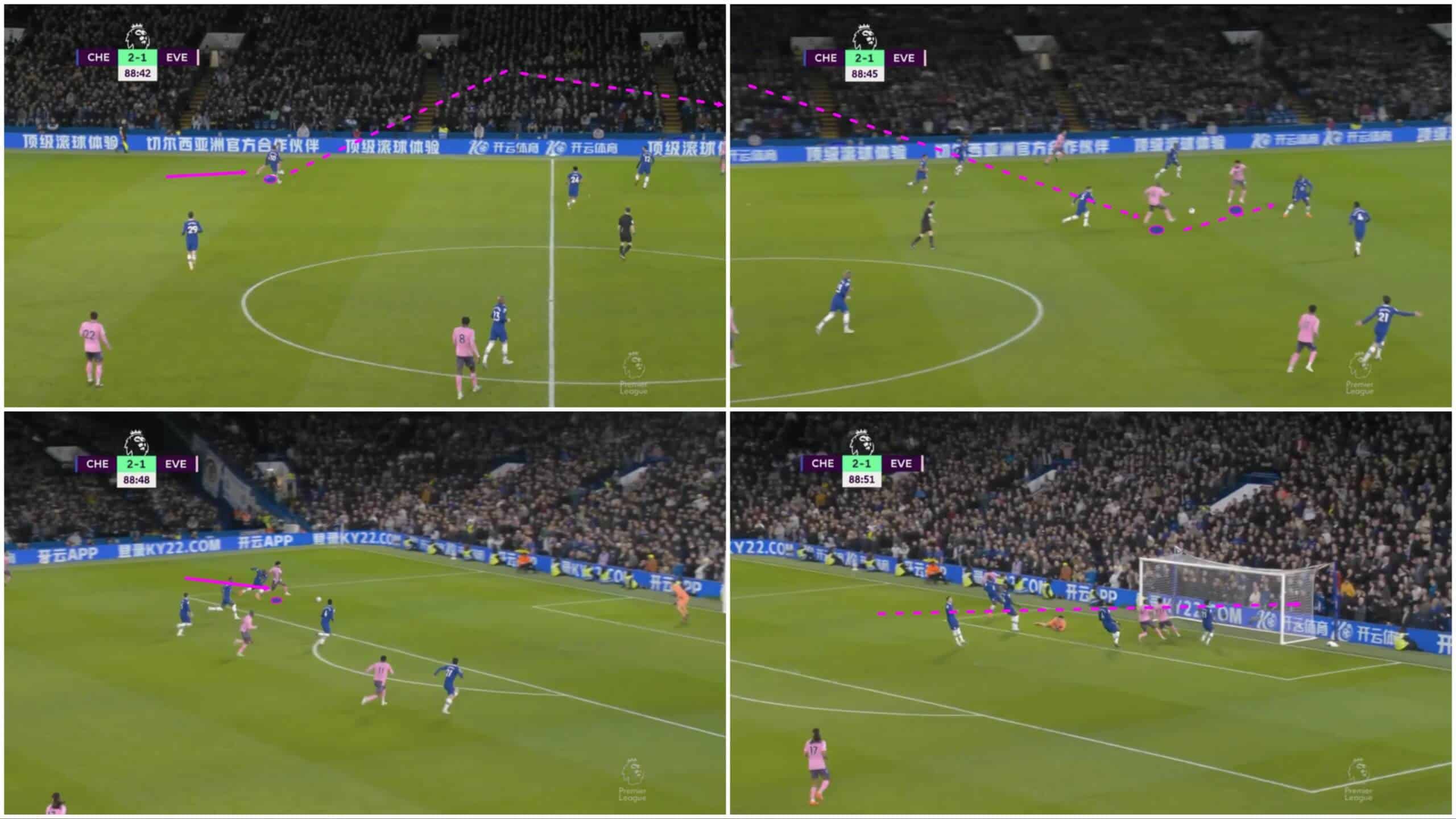
It’s common to see Everton try to find a player in the backline with enough space to get their head up, pick out a long ball forward and try to create something. In general, these balls aren’t just hoofed upfield carelessly. They are well thought-out and measured more often than not, such as the one we see here, which found a player between the lines in space to turn and play a more advanced attacker through on goal.
Two passes. That’s what it took for Everton to move from a very non-threatening position at left centre-back (almost left-back due to the pressure from the Chelsea player) into a goalscoring position. This resulted from the left centre-back’s composure to get his head up and pick out an excellent long ball forward behind the opposition’s midfield, spotting a teammate’s movement and executing excellently.
Of course, long balls are still high-risk. But there are specific measures one can put in place to achieve success like Everton did here, which includes taking care and consideration about the pass and initially finding a player in enough space to reasonably take that care and concern before playing it forward.
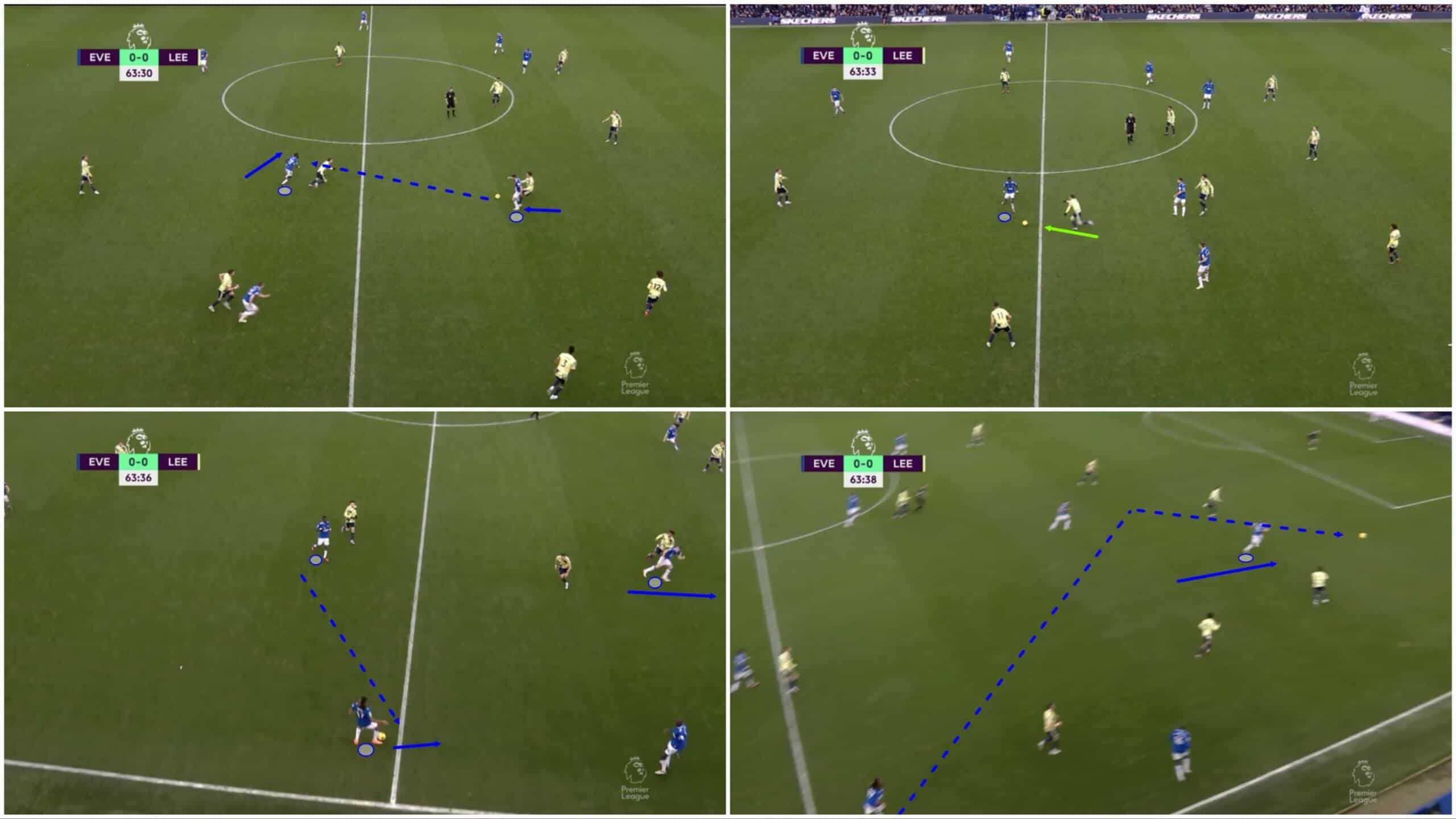
Everton’s full-backs are often the ones with time and space to get their heads up and pick out that forward pass, primarily due to the opposition’s pressing tactics, which will often see them congest the centre, thus forcing the Toffees out wide.
We see an example of this in figure 6, where Leeds hounded Everton out of the centre. Yet, once they found a way to get the ball out wide, the pressure eased considerably, allowing Alex Iwobi to pick out a dangerous pass into the channel for the attacker to chase.
Ashley Young is great at finding space in these areas and is very comfortable playing these types of passes from here with solid accuracy. Expect to see plenty of this from him next season. Furthermore, Everton love playing crosses from reasonably deep as well, looking to get the ball in early and create some chaos for a forward to potentially capitalise on in the penalty area. The full-backs will also play a vital role here due to the space they can generate.
Defensive phase
Despite actually conceding more goals per 90 under Dyche than they did under Lampard, Dyche organised Everton’s press and general defensive structure quite well last season; Dyche is known for his capability of organising the team in this area, and Toffees fans can be confident of the coach.
Everton made more recoveries under Dyche (92.39) than under Lampard (80.75) per 90. However, this is somewhat to be expected when you play with so much less of the ball and isn’t indicative of Everton improving defensively under Dyche.
However, Everton’s PPDA also dropped a not-insignificant amount under Dyche compared to Lampard — from 12.89 with the former manager to 11.78 under the current boss. Indeed, Everton pressed more effectively and more aggressively under their current manager than they did with Lampard, and this is where the difference between the two coaches in terms of their ability to organise and structure the team’s defence was felt the most.
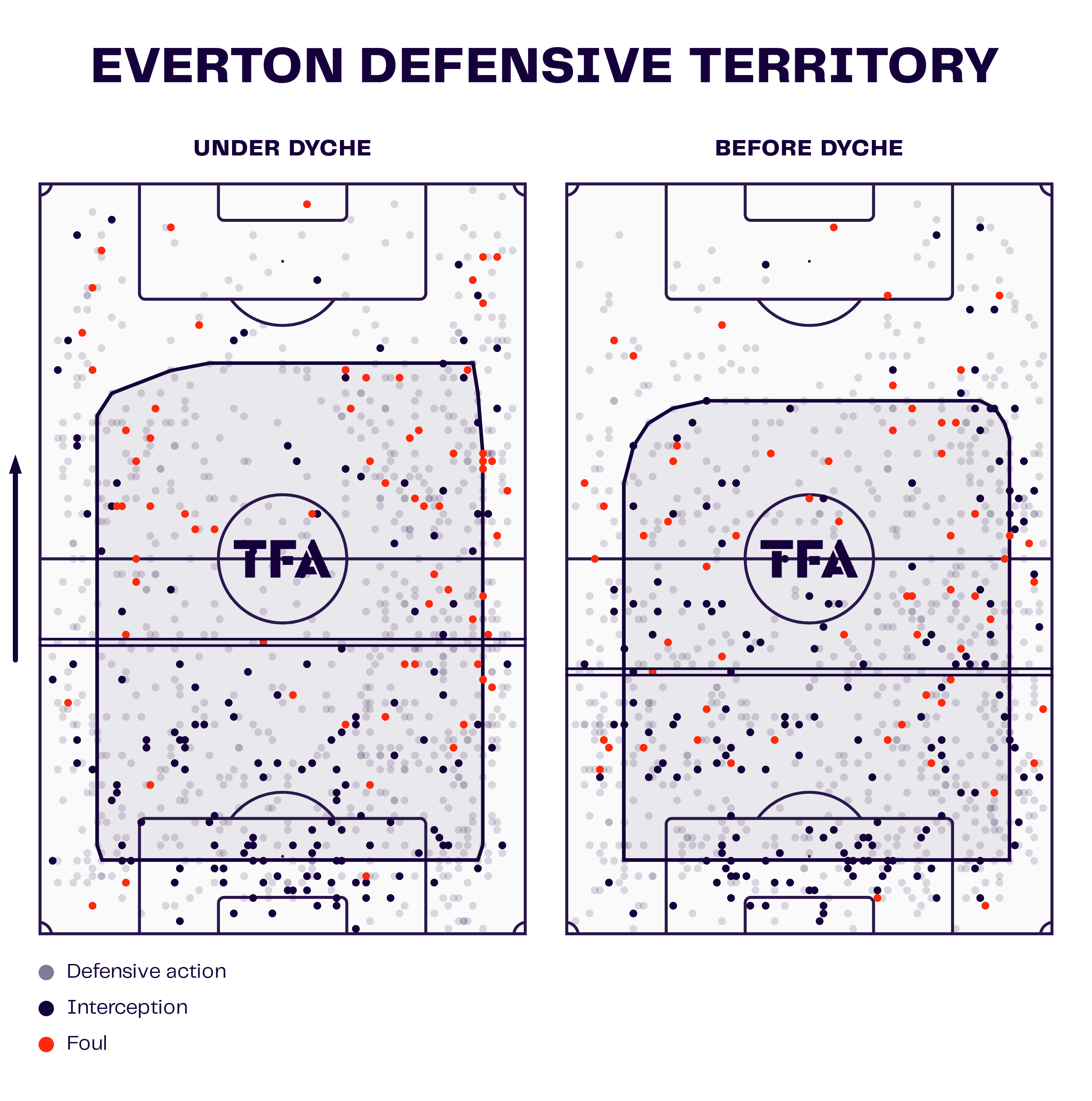
Everton were able to win the ball back in the middle of the pitch more frequently and got pinned back less. This created more opportunities for counterattacks, pivotal to their Premier League survival. The above defensive actions map highlights how Dyche’s side pressed higher and played with a higher backline than last season’s pre-Dyche games.
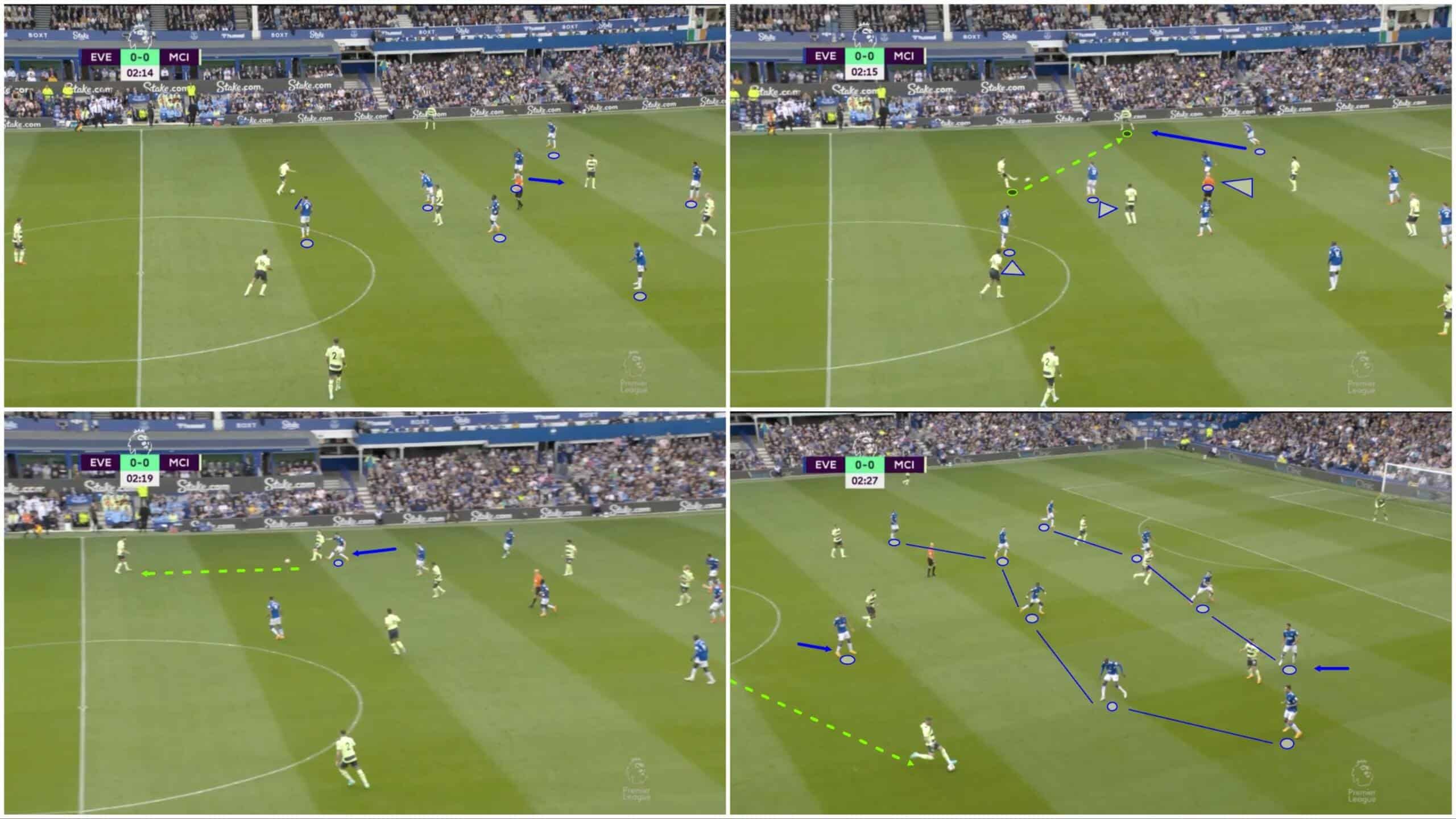
Looking at how he set his team up without the ball, Dyche used a few different formations but mostly played with a 4-5-1, with 4-4-1-1 also occurring frequently. They mostly defended in a mid-block and were marked in a position-oriented zonal system, making the bank of four and bank of five very clear to see most of the time.
In figure 8, versus Manchester City, we see some of the tactics Dyche used to combat Pep Guardiola’s treble-winners. In the top-left image, for instance, right-winger Iwobi tucked in a bit to guard against the pass into the left half-space. At the same time, Calvert-Lewin at centre-forward checked his shoulder and repositioned himself to ensure Rodri was kept in his cover shadow.
In the most valuable positions, the central midfielders had to remain disciplined but also get tight to a player who drifted into their zone, as we see with Abdoulaye Doucouré advancing to cover the City player drifting across from James Garner. Cover shadows, as highlighted in the top-right image, were vital to Dyche’s defensive approach, as was aggressive pressure when players received with their back to goal or at an awkward angle, such as in the top-right image.
Right-back Nathan Patterson forced Phil Foden to move back, relaying the ball to his centre-back. Eventually, as play moves across the field to the right, City are forced long as they find it too difficult to play through Everton’s organised defensive system. Unfortunately for them, of course, City had Erling Haaland to be aiming for up front, which isn’t disastrous, so Guardiola’s side did win this game, scoring three times.
However, we still see some of Dyche’s fundamental defensive principles and how they effectively denied City access to critical areas of the pitch via his tactics in action above.
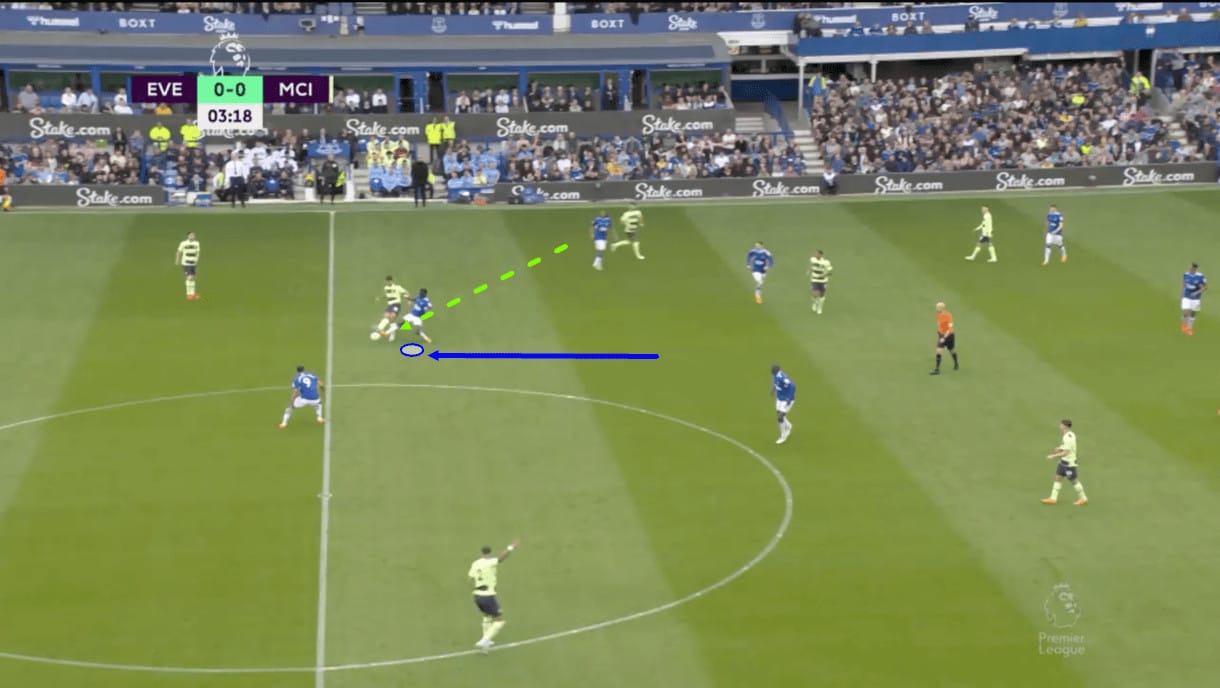
Denying City possession centrally was a key focus for Dyche in this game. It’s well-documented how effective Rodri, in particular, is in these deep areas when given time and space on the ball, so Everton’s central midfielders were sometimes called into action if Calvert-Lewin could not prevent the pass into the Spanish midfielder.
This is a benefit of playing with three central midfielders or a ‘10’ behind the striker; they can slot into midfield or add a second body to the first line of defence quite quickly, making them a very versatile defensive weapon.
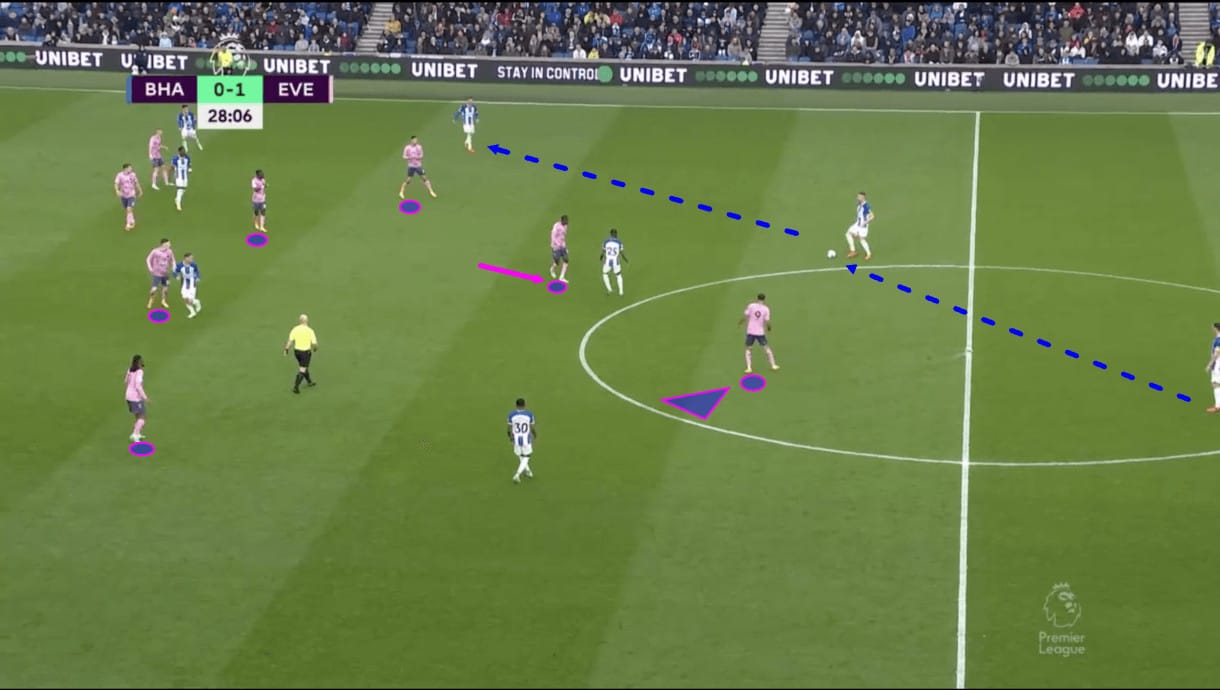
We see another example of Everton’s defensive structure in this game versus Brighton. This one ended far better for the Toffees. Still, the same defensive principles, which Dyche managed to coach masterfully (major horizontal and vertical compactness, players supporting each other by covering space when others press, collective commitment and energy) and many of the same tactics (use of cover shadows to deny central progression, the backline pushing up to limit the space, Doucouré as a ‘10’ hovering between the first and second lines of defence depending on where his presence was needed, pressing aggressively on the awkward touch or poor body positioning when receiving) were largely on display.
Here, the Toffees denied Brighton any joy through the middle of the park, with Dyche delivering an excellent out-of-possession performance versus Roberto De Zerbi. As we’ll see more in the next section, this wonderful defensive organisation helped Everton to secure a 5-1 victory in this game versus an in-form team who finished far higher up the table — no small feat.
Transitions phase
Transitions were huge for Everton under Dyche, particularly transitions to attack. They had 2.5 counterattacks per 90 under their current manager last season, which was an increase on the 1.85 they had under Lampard. Furthermore, 1.17 of their counterattacks per game ended in a shot under Dyche compared to 0.8 under Lampard. This equates to 46.8% of their counterattacks ending up in a shot under Dyche compared to 43.2% pre-Dyche.
Dyche’s football at Everton has been incredibly transitional, and they’ve done a great job of exploiting their strengths in this area. Their performance against Brighton — a team that likes to control possession more — was an excellent example of the two teams’ contrasting styles and how Dyche’s non-possession-based, transitional style can work.
Everything about how Dyche set up this team, from the aggressive pressing without the ball to the direct play with the ball, was designed to maximise transitions and their effectiveness in them.
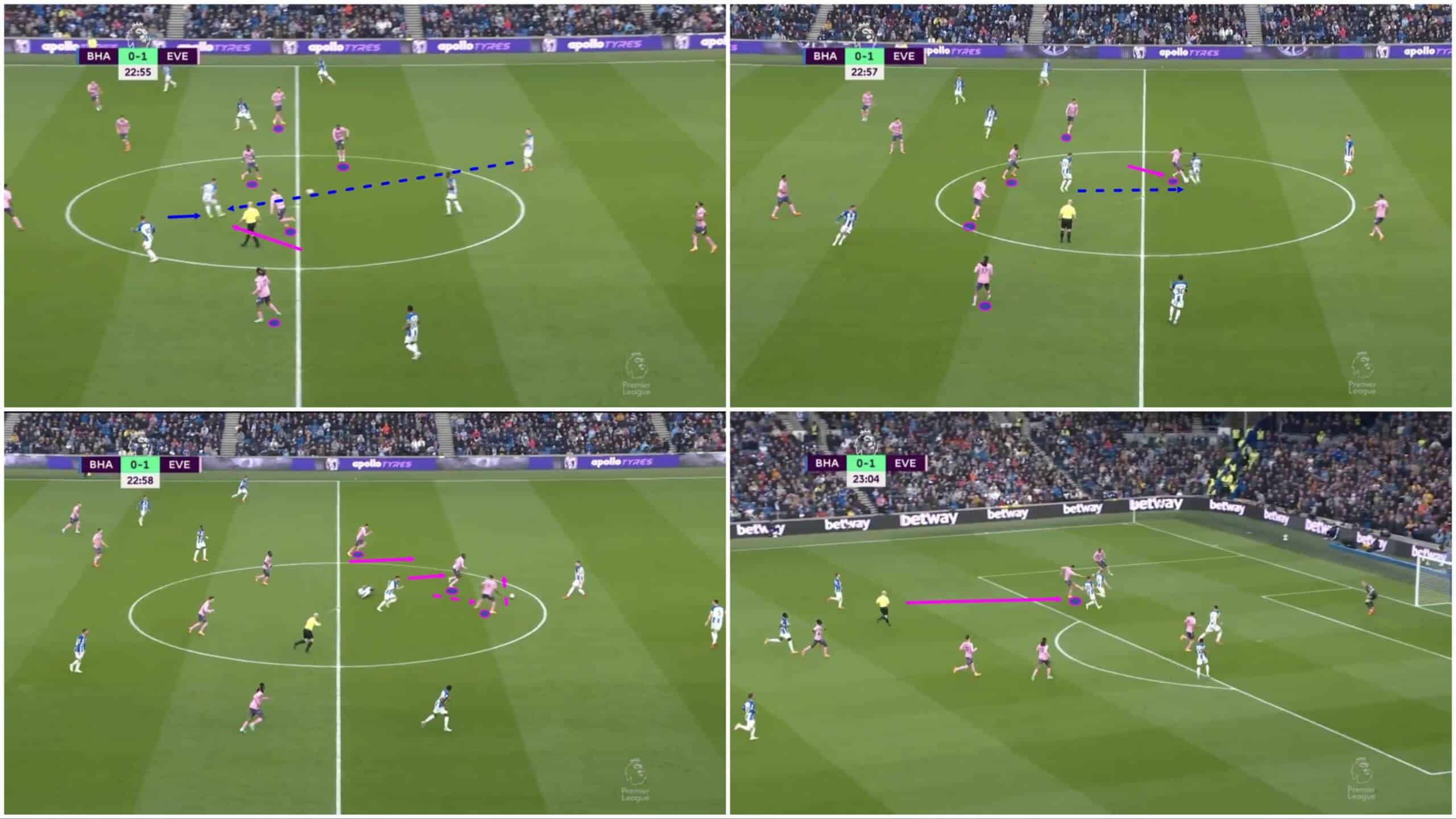
In figure 11, we see how Everton reacted quickly to a ball being played into midfield, prevented the receiver from turning and forced the play backwards. This triggered Doucouré’s press, and the Frenchman succeeded in dispossessing the Brighton player, kickstarting a counterattack and quickly setting up a shooting opportunity for his side.
In less than 10 seconds, Everton moved from a precarious position with the opponent threatening to penetrate their midfield to a potential goalscoring position. This highlights the impact of Dyche’s defensive organisation on Everton’s goalscoring numbers. Transitions were critical for Everton’s survival, and Dyche helped to create more of them by implementing a better defensive structure.
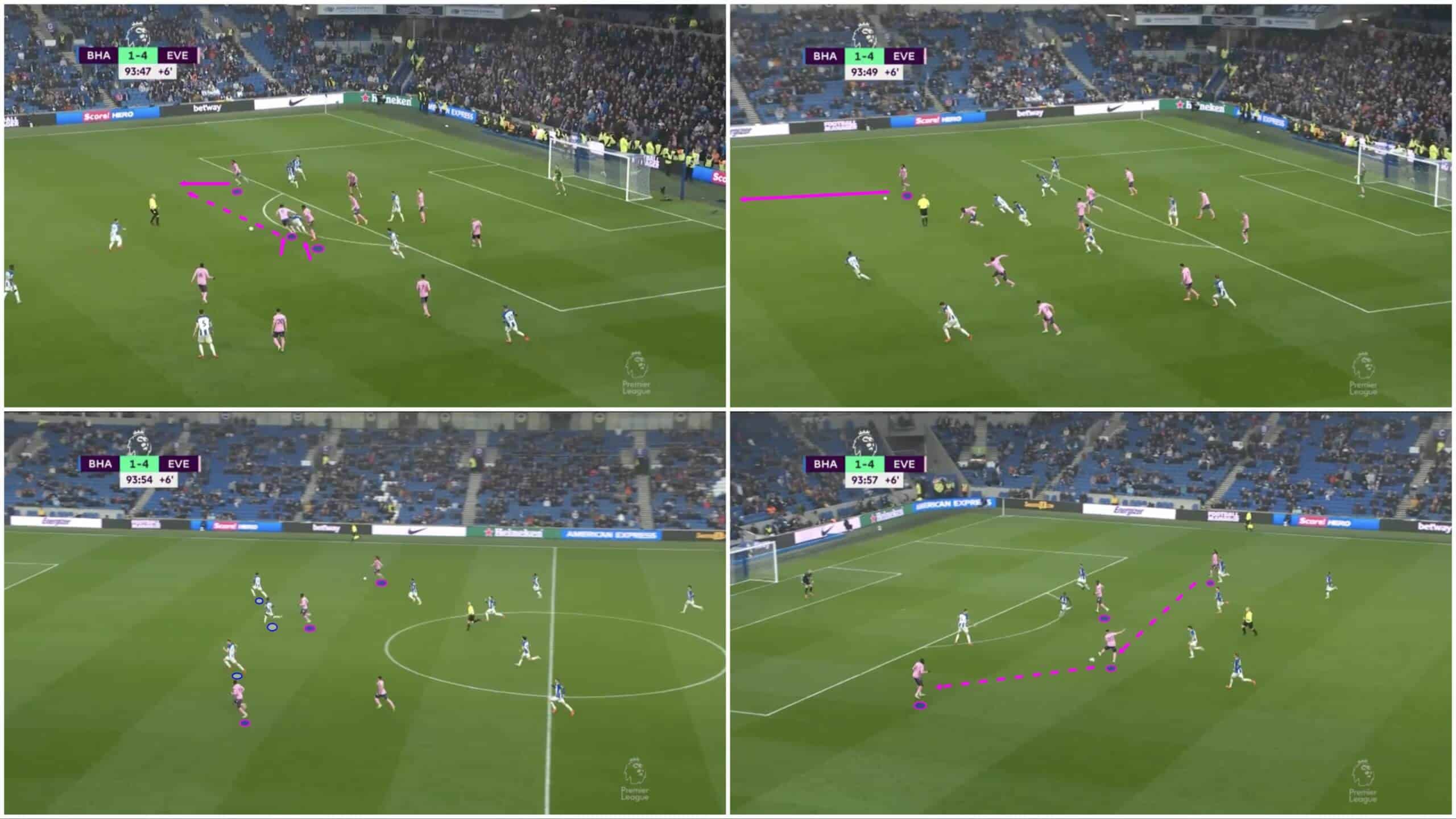
Another example from this game versus Brighton highlights several vital principles of Everton’s defensive play and counterattacking game. Firstly, note the time on the clock. It’s the 94th minute. The Toffees are three goals up, but everyone is back on the edge of their box, defending like their lives depend on it.
Then, as the counterattack happens, bodies quickly rush forward in support. This is the collective effort and energy that Dyche requires as a principle of his approach. The team’s commitment to fulfilling this requirement was vital for their success under the 52-year-old manager.
Iwobi was crucial to the success of this counterattack as he carried the ball forward on the right wing from the edge of one box to the edge of another, demonstrating great fitness and energy, as well as technical dribbling skill and sound decision-making in the final third once he reached it along with enough teammates to overload the opposition.
Everton will look to exploit the space out wide in transition as the opposition will pretty much always leave this space more exposed than the centre — why wouldn’t you? But they can still create from here, and pacey dribblers with good decision-making ability like Iwobi are essential for making that happen.
It’s worth noting that if Everton fail to break away on the counter and lose the ball back quickly, either due to a poor pass or losing a duel, this can create and has created opportunities for the opponent to take advantage of the momentary disorganisation in Everton’s shape. So, reliability on the ball and good decision-making are so crucial for the team’s success in this phase.
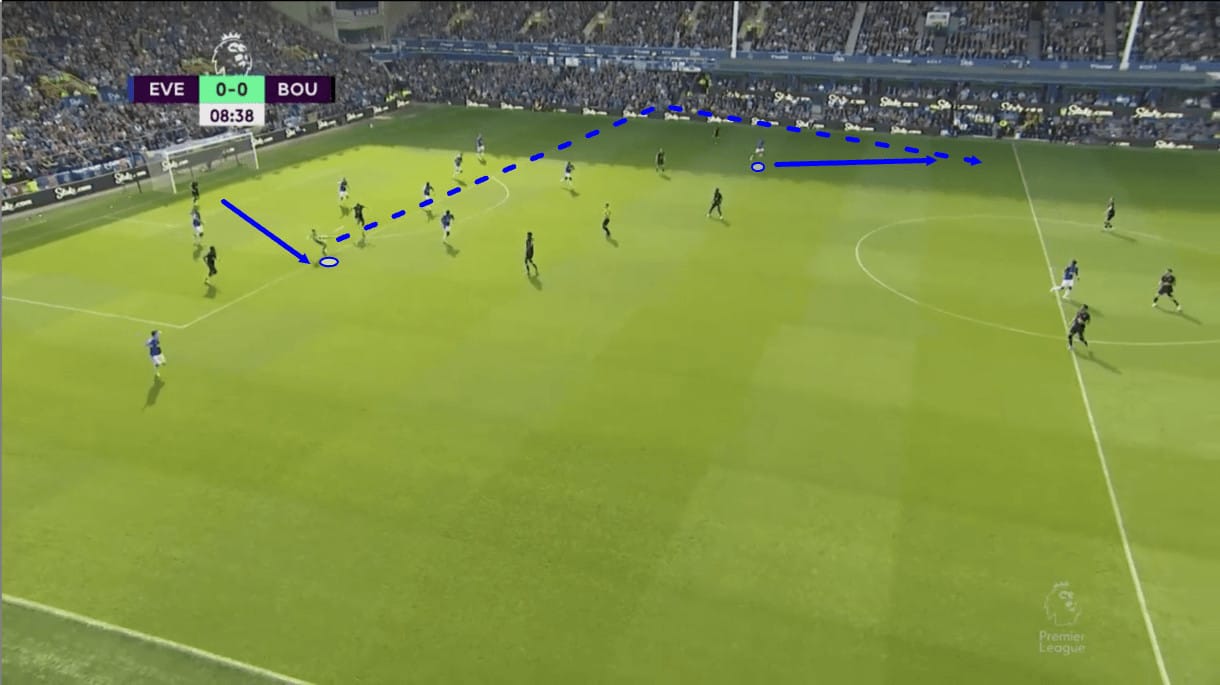
Following an opposition attack where they send plenty of bodies forward, you can also expect to see Jordan Pickford quickly launching long balls over the top to try and help his team to exploit the opponent’s vulnerable backline.
In terms of defensive transitions, this is an area in which Everton are particularly weak and must improve drastically if they’re to make their way up the table. They need to ensure their rest-defence structure is sufficient to suffocate opposition attackers if they get on the ball after a Toffees attack to ensure they can’t progress upfield and hurt the weakened Everton defence.
At times, Everton’s holding midfielder can become isolated as the other central midfielders and the wingers advance in attack. This can leave him with an impossible area of land to defend and ultimately leave the defence exposed.
Enough to survive, even on a shoestring
Top-flight survival is the bare minimum expectation for a club of Everton’s size, stature and pedigree. However, it has been their primary focus for the last couple of seasons, with the prospect of achieving anything more than that a long way off.
With several significant departures confirmed and not much in the way of incoming transfers this season, it’s tough to see how the Merseyside club could realistically set their sights on much more than a minimum 17th-place finish again in 2023/24.
Of course, they could achieve more than that, though. And in Sean Dyche, they have a manager with a proven track record of overachieving in this very division.
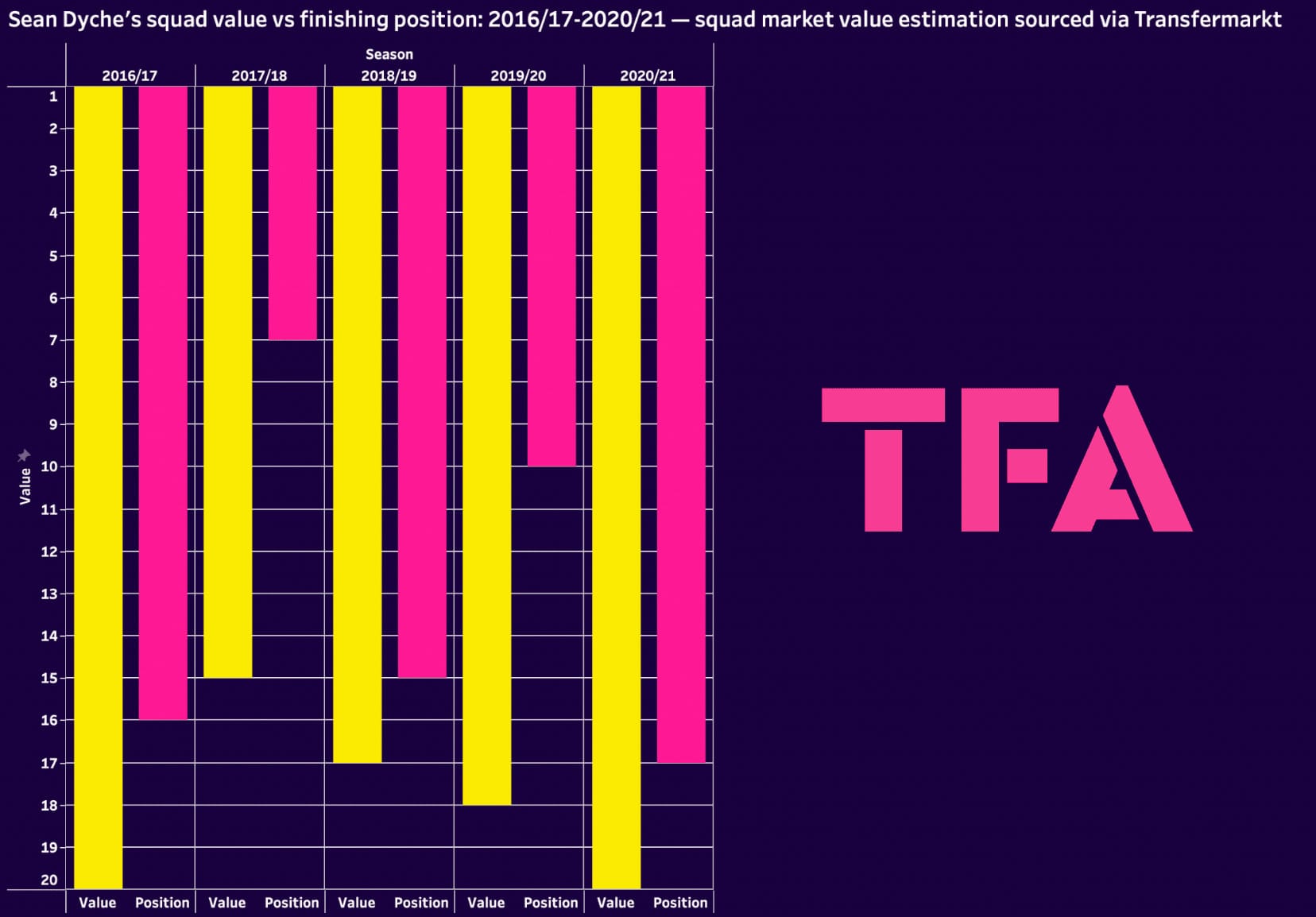
Figure 14 shows Burnley’s ranking concerning their Premier League rivals in squad value, per Transfermarkt, for each of their top-flight campaigns from 2016/17 to 2020/21 compared with their finishing position in the league for that same time.
This was a five-season stretch in which Sean Dyche helped his team evade the drop year after year despite being at the helm of one of the weakest squads in the league, exemplified by their squad valuation in each of those five seasons.
In three of the five seasons (2016/17, 2019/20 and 2020/21), Burnley were valued in the bottom three — relegation territory. Despite that, they survived.
The highest Burnley ranked in terms of squad value in any of the five seasons was 15th in the 2017/18 campaign, and Dyche guided the Clarets to an impressive seventh-place finish that term.
At the time of writing, Everton rank 12th for squad value heading into the 2023/24 campaign, which is well clear of the drop zone and actually allows Dyche to enter the season with the strongest squad he’s ever had compared to their rivals purely judging based on market valuation.
Of course, there are other important factors to consider here as Everton approach the new season. The atmosphere around the club and its ownership is bad right now — there’s no other way to put it. Furthermore, Dyche hasn’t received much backing from the owner at all this summer, and the Toffees will enter the season with much of the same players as last term except with a good chunk having now departed.
These factors can have a seriously detrimental impact on the team’s morale, which can make their talent count for less. So make no mistake about it, Dyche has a significant challenge in fostering a positive environment at the club that gives his players the best possible platform to enter match days with the required mindset to show what they are capable of.
Dyche expects high levels of professionalism day-in-day-out, respect for one another and a positive attitude from his players both on and off the pitch, as the manager detailed when interviewed for the High-Performance Podcast, which provides a lot of quality insight into his management style and how he’ll approach this job.
We’ve seen plenty of examples of this already manifesting itself in his team’s performances by how they played, especially without the ball, during his tenure last season. Suppose they can start this season with the same attitude and principles both on and off the pitch. In that case, that will go some way to drowning out the negative noise surrounding the club and helping Dyche not just to help Everton survive but push on beyond the expectations based on their squad’s quality and perhaps even threaten to break into the top half.
Based on what we saw last season, this seems a long way off. Still, they have the quality to achieve this, especially if Calvert-Lewin can stay fit, Danjuma arrives and delivers the quality of performance he’s proven capable of in the past, Amadou Onana stays at the club and is used in a way that highlights his strengths just to name a few of the potential critical players for the Toffees this season.
While there’s a bit of a bleak feeling around the club, nothing in terms of quality and resources will scare Dyche.
Key player: Dwight McNeil
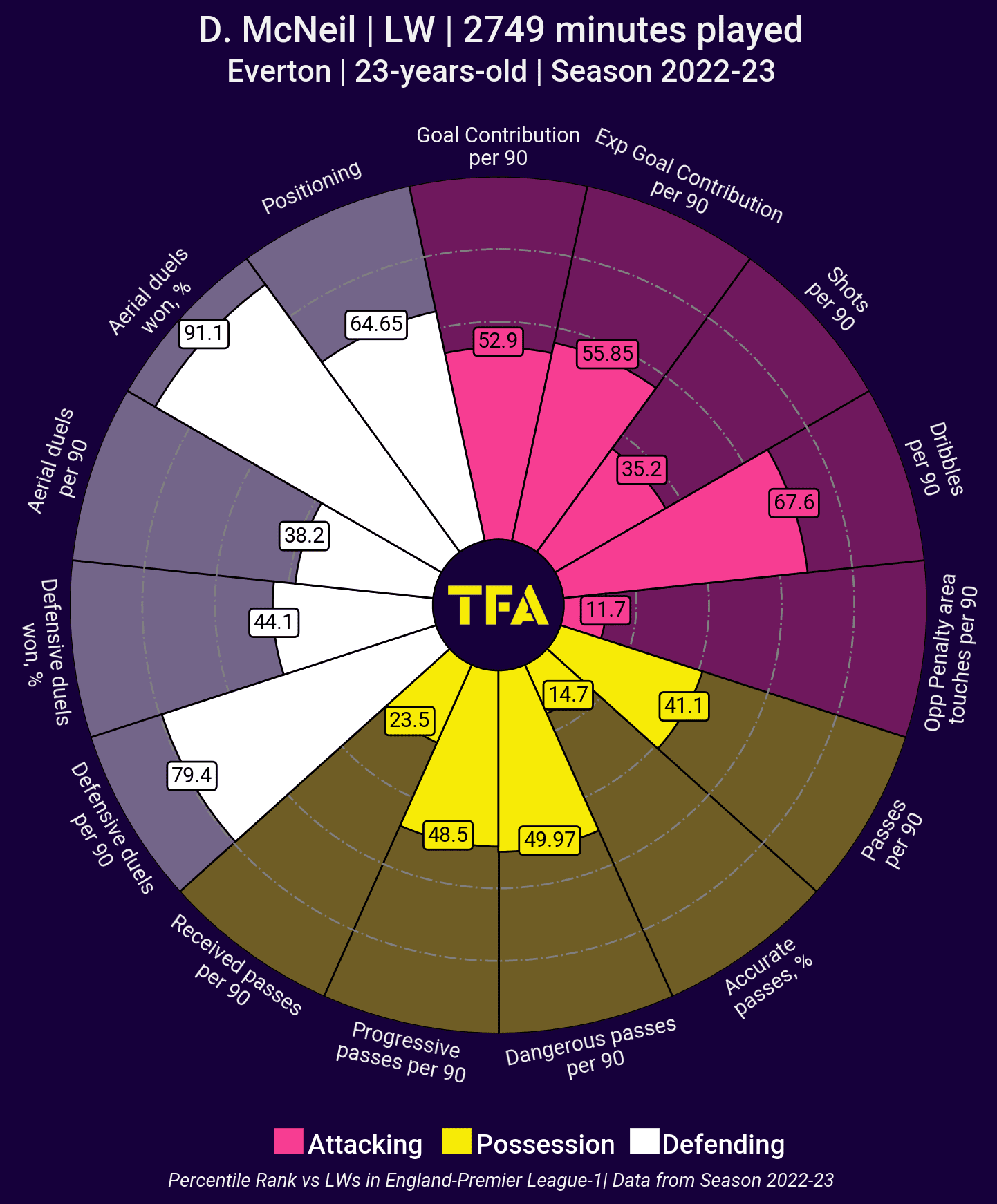
Dwight McNeil and Alex Iwobi are both very important players for this team due to their combination of technical quality, decision-making in pivotal areas and, crucially, defensive work rate.
We’ve chosen McNeil — someone Dyche is very familiar with from his time at Burnley — as our key player. The winger finished last season as the Toffees’ top goalscorer but made just three assists.
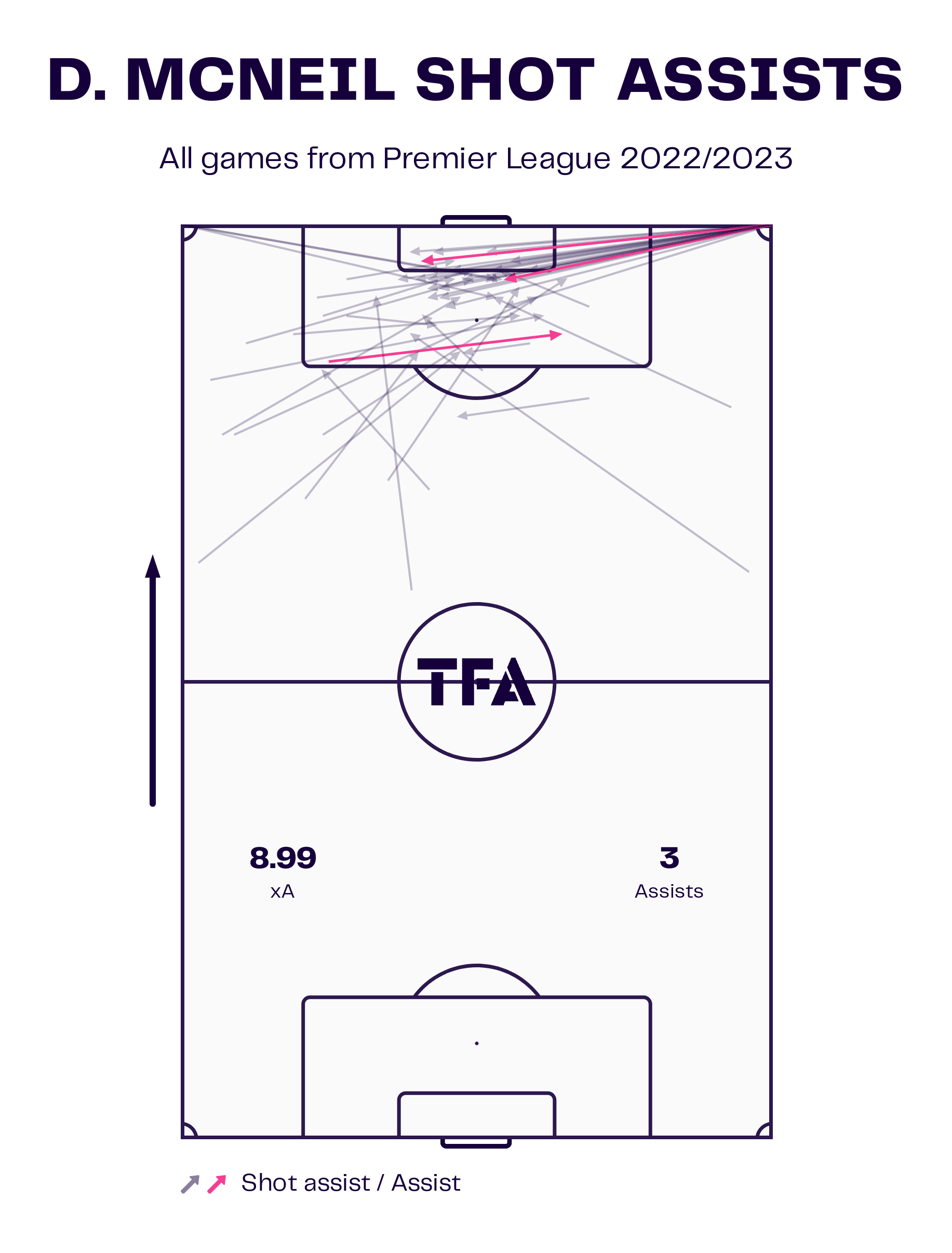
However, as the above shot assist map indicates, McNeil could’ve had so many more assists based on the quality of his deliveries; they weren’t finished as frequently as his passing deserved. He underperformed his xA numbers by almost six. If he continues providing the same level of service next season, his actual assist numbers will surely rise to match up with his xA more, especially if Calvert-Lewin can retain fitness.
McNeil and Calvert-Lewin haven’t had a chance to play together a tonne yet and develop the chemistry that was envisioned when Everton signed the winger, but if Dyche can foster a stimulating environment for the pair this season, they could prove to be a very dangerous duo.
With his defensive output, creative crossing ability and dribbling quality — which will be especially useful in Everton’s counterattacks — McNeil represents a near-perfect option for Dyche on the wing.
One to watch: Abdoulaye Doucouré
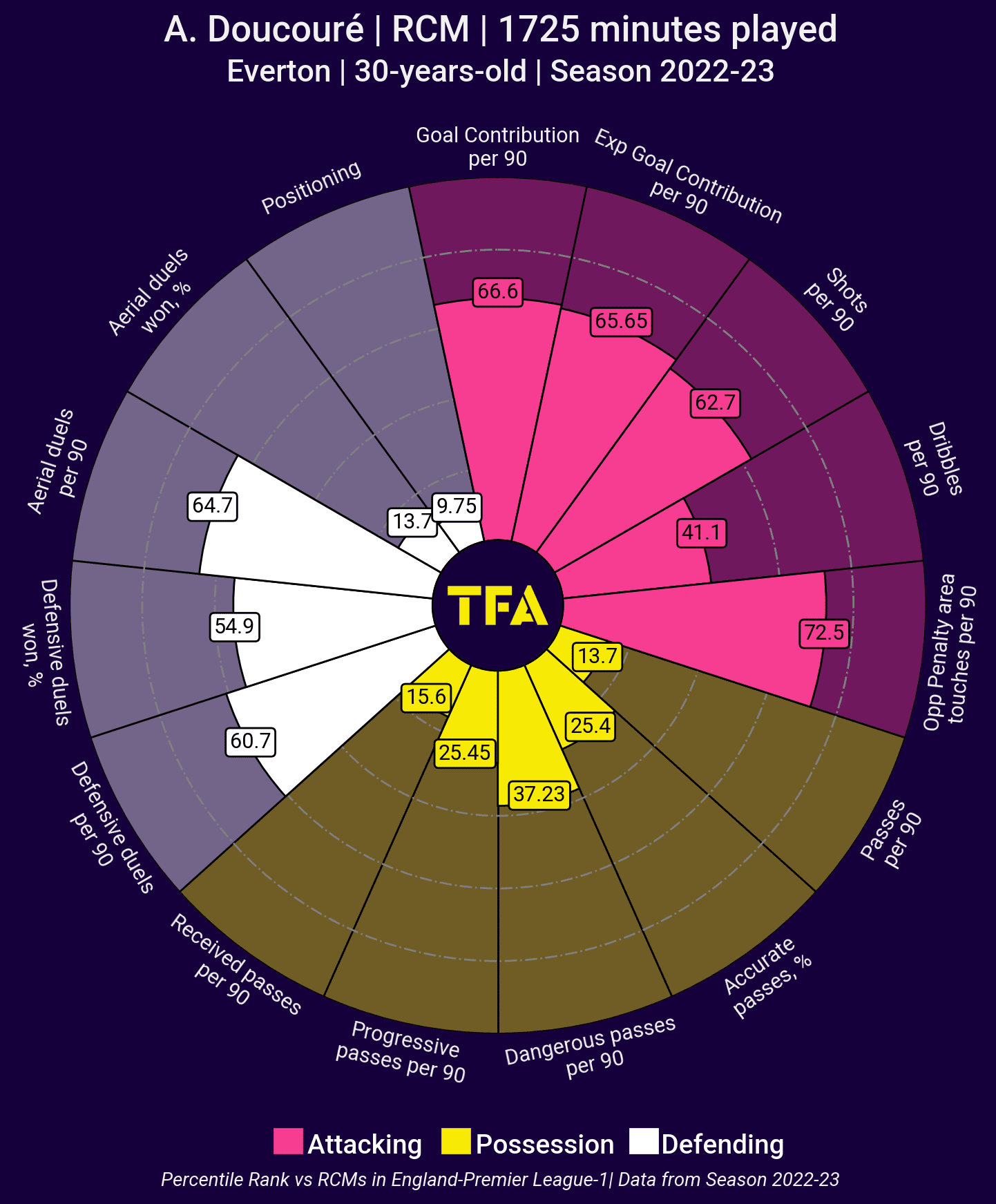
Abdoulaye Doucouré is who we’ve decided to highlight as our player to watch for Everton heading into the new season. We already discussed the importance of his role out of possession for Dyche last season, and it should come as no surprise that the Toffees jumped at the chance to extend his contract by one more year this summer.
Doucouré scored five goals and provided two assists last season. They all came during Dyche’s 18-game tenure in charge. So, it’s not just in terms of defensive organisation, structure and energy that the Frenchman will be valuable for his team, but also in terms of goal contributions. He’s an excellent option for the ‘10’ role in Dyche’s squad because he provides work rate off the ball while also being a threat once his team regains possession.
The midfielder was out of action for three games in April, and the Toffees took just one point from those three games, ending a four-game unbeaten run. Within three games of his return, he put two past Brighton and delivered a crucially important performance in defensive phases to earn what proved to be a vital three points for his team.
With all of that said, from our analysis, he is clearly a critical player for this team. He plays an interesting role and can help Everton to improve their position next term.
TFA Verdict: 17th
The data tells us that Everton actually concede more chances and goals under Sean Dyche than before he arrived – and nothing about the summer recruitment really suggests that is going to change. But, if one manager likely to be in a relegation scrap knows what to do to stay up it is Dyche – though didn’t we say that before his time ended at Burnley? They’ll stay up again, just.

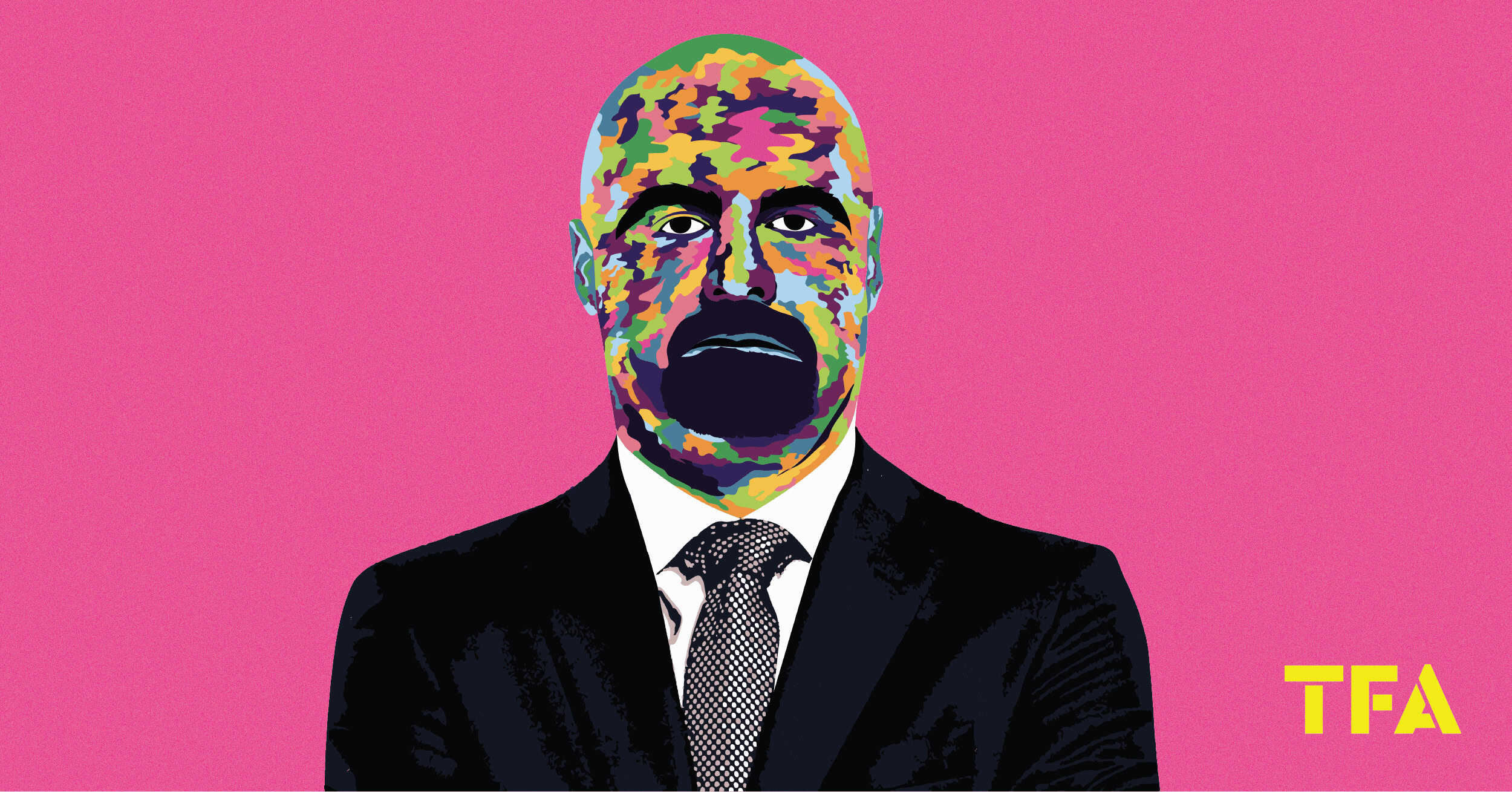



Comments